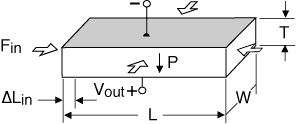 Longitudinal
generator (left) and transverse generator (below). Diagrams found on
Piezo Systems, Inc.
(without permission)
Longitudinal
generator (left) and transverse generator (below). Diagrams found on
Piezo Systems, Inc.
(without permission)Piezoelectric materials are very useful by virtue of both the direct effect and the indirect. They are especially useful in detecting movement - for example seismic tremors can be detected by the fact that when the material is squeezed and stretched it produces a potential difference which can easily be quantitatively measured. This particular application is often used in microphones as well.
These materials can also be used as generators or actuators - a device that uses a small electrical current can easily incorporate a piezoelectric material as an easy way of generating that current. For example in ignition systems to provide a spark, or even for gas cigarette lighters. Single layer piezoelectric materials can be used as generators in either a longitudinal or transverse conformation. The voltage is produced as the material attempts to return to its original state.
 Longitudinal
generator (left) and transverse generator (below). Diagrams found on
Piezo Systems, Inc.
(without permission)
Longitudinal
generator (left) and transverse generator (below). Diagrams found on
Piezo Systems, Inc.
(without permission)

Motors are also a frequent applications for piezoelectric materials, but only for very small motors as the displacement created by application of a voltage across a single layer of piezoelectric material is for longitudinal motors in the order of nanometers, and for transverse in the order of micrometers. The action is very much the opposite of that shown for generators in the two diagrams above.
Transducers are another typical application for piezoelectric materials, and it utilises both the direct and indirect effects. A transducer converts between electrical energy and vibrational mechanical energy. A piezoelectric transducer is advantageous over any electromagnetic apparatus which can achieve the same affect because they are much smaller and more efficient.